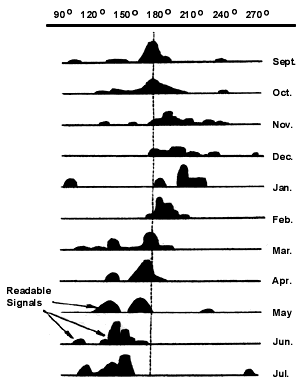
Sommer Antennas: Fixed Directional Antenna?

 [ORDERING]
[ORDERING] [COMMENTS]
[COMMENTS] [REVIEWS]
[REVIEWS] [BACKGROUND]
[BACKGROUND] Sommer Antennas: Fixed Directional Antenna?  |
 [ORDERING] [ORDERING] [COMMENTS] [COMMENTS] [REVIEWS] [REVIEWS] [BACKGROUND] [BACKGROUND] |
 Information from "Neues Van Rohde, V. Schwartz," Okt/Nov 1973. |
Large Antenna in a fixed direction?If your antenna is fixed in one direction, as in the chart above (i.e., north to south), you will notice that your antenna works perfectly only during fall and spring. Why is this so? Ionospheric conditions vary by season. This can cause deviations of up to 45 degrees from the direct path. (See chart on the deviation of radiation maxima during the year.) These deviations occur not only in the described north-south direction, but also in all other directions. An antenna with a narrow radiation pattern is therefore most useful if it can be rotated to the maximum receiving angle, as dictated by the season. Example: A large fixed rhombus antenna may offer a 12 dB "DX-gain" over a log-periodic antenna in the north-south direction, but this will only be true in September and March. Although the log-periodic antenna generally offers less gain, it usually has the advantage of being rotatable. Thus it can be rotated to the direction of maximum signal strength, whatever it might be at that time of year, and actually acheive better results at times than the fixed rhombus. |
 Sommer Antennas
Sommer Antennas 
P.O. Box 710
Geneva, FL 32732
Phone: (407) 349-9114 | Fax: (407) 349-2485